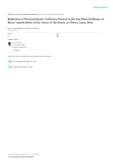Reduction of Thermotolerant Coliforms Present in the Sea Water by Means of Micro-Nanobubbles of Air-Ozone of the Beach Los Pavos, Lima, Peru
Fecha
2017Metadatos
Mostrar el registro completo del ítemResumen
The marine pollution in Latin America and the Caribbean is due to domestic sewage discharges into the sea,
which do not receive previous treatment, thus generating health problems for the population. This is due to the
presence of thermotolerant coliforms and solid waste on the beaches in the Peruvian coast. The beach Los
Pavos, as well as other beaches in Lima, is a very popular recreation area especially in summer. This beach
complies with the parameters of beaches cleaning quality and presence of hygienic services, thus qualifying
as a healthy beach. However, the analysis carried out in this research have found the presence of
thermotolerant coliforms of 1400 NMP / 100mL at pH 7.13 and 44.5 ºC (or 112.1 ºF), exceeding the
environmental standard values.In order to reduce this considerable amount of thermotolerant coliforms, sea
water microbubbles (MNBs) of air-ozone were tested. These micro-bubbles were generated by a device for
the generation of Micro Nanobubbles invented by Dr. Jhonny Valverde Flores. The air / ozone volume ratio
was 3/1, the size of the MNB was 7 µm, with a water flow of 4.67 L / min and a pressure of the air-ozone
mixture of 90 PSI.
The volume ratio of sea water / water with MNBs for sample A was 3/1, for sample B of 1/1 and for Sample C
of 1/3. As a result of research, the presence of thermotolerant coliforms of sample A decreased to 56 NMP /
100mL, of sample B decreased to 79 NMP / 100mL and of sample C decreased to 130 NMP / 100mL,
achieving an efficiency of 96%, 94.36% and 90.71%, respectively.
Colecciones
- Lima Norte [6]
El ítem tiene asociados los siguientes ficheros de licencia:


